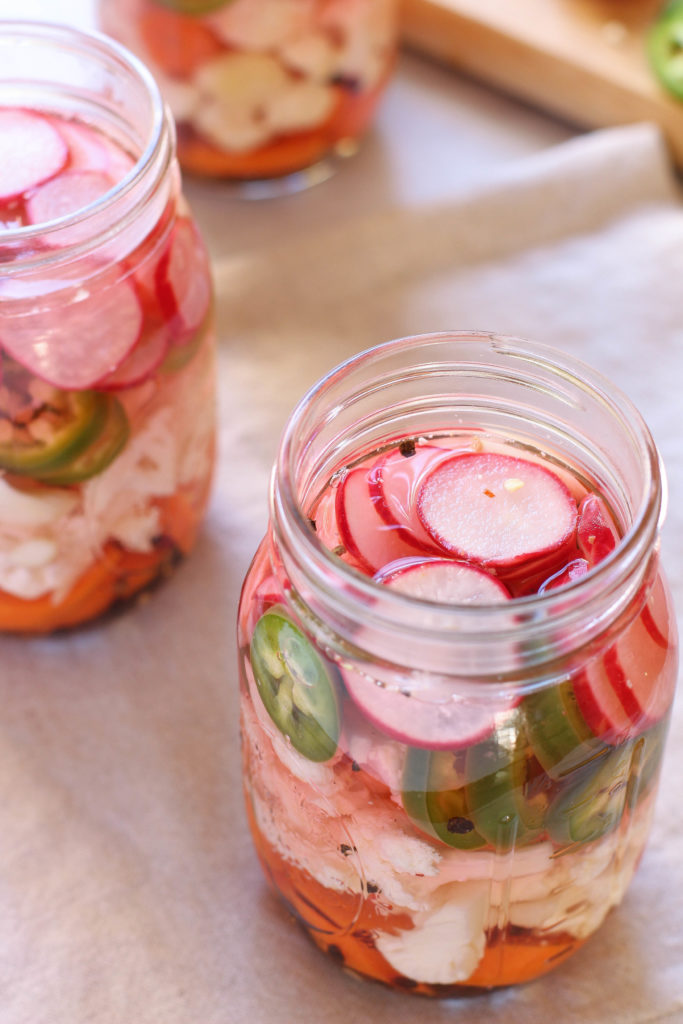 Have you ever had escabeche before? There’s not much to it, usually carrots, cauliflower, jalapeños, and onions quick pickled and served at Mexican restaurants as a starter alongside chips and salsa. Crazy simple but also highly addictive. So addictive, I’ve been taking down a third of a jar on a daily basis since I perfected this recipe. You’re probably wondering what could be so addictive about some veggies soaked in vinegar, welp, I just know what I like. And right now I reeeaallly like eating these tangy, uber crunchy veggies for a mid-morning (and mid-afternoon) snack on a daily basis. They just hit the spot.
Have you ever had escabeche before? There’s not much to it, usually carrots, cauliflower, jalapeños, and onions quick pickled and served at Mexican restaurants as a starter alongside chips and salsa. Crazy simple but also highly addictive. So addictive, I’ve been taking down a third of a jar on a daily basis since I perfected this recipe. You’re probably wondering what could be so addictive about some veggies soaked in vinegar, welp, I just know what I like. And right now I reeeaallly like eating these tangy, uber crunchy veggies for a mid-morning (and mid-afternoon) snack on a daily basis. They just hit the spot.
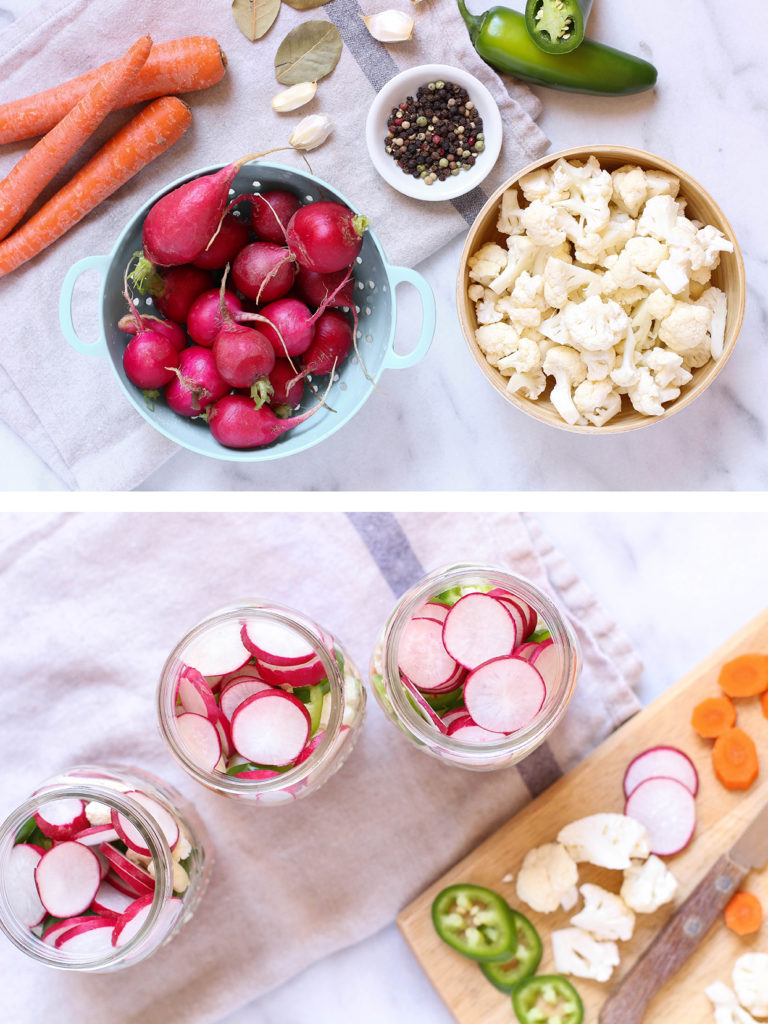
My theory is that it’s the combo of veggies – carrots, cauliflower, jalapeños, and radishes – which shake up the traditional escabeche mix. I had to omit the onions guys, I just had to. My favorite part about escabeche is how crunchy the veggies stay, literally for weeks, but not onions. Nope, there’s no helping those, so leave ’em out, I say! A lot of escabeche recipes also call for sauteing the veggies in a bit of oil before submerging them in the water and vinegar mixture. To this step, I also say, forget about it! It’s not necessary and will only lead to soggy veg.
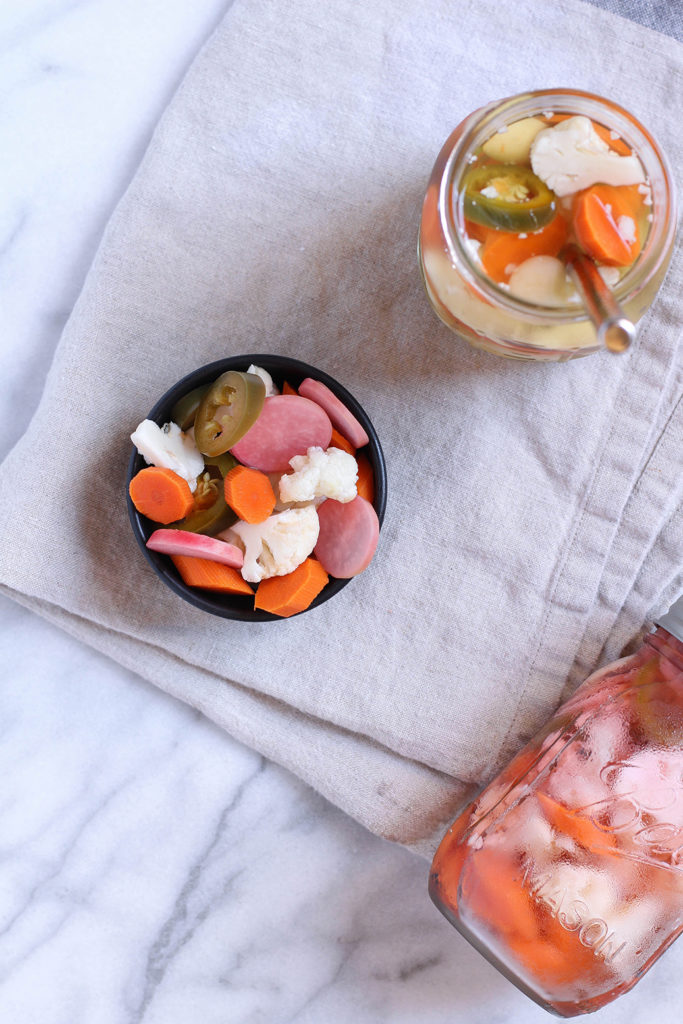
The pickling liquid itself is pretty basic – a few bay leaves, whole peppercorns, salt, sugar, garlic cloves – allowing the flavor of the veggies to shine through. I can’t decide which veggie is my favorite, probably the carrots although cauliflower comes in a close second, mainly because I’m generally not a huge cauliflower fan but I could eat an entire head of the stuff in pickled form. The radishes are pretty awesome too. However, if you don’t want your pickling liquid to eventually turn a pinkish hue (and the cauliflower along with it) then leave out the radishes. The jalapeños provide necessary spice (this is a Mexican dish, after all), but be sure to deseed them. I know what you’re thinking, I can handle the heat! Trust me on this though, if you don’t take out the seeds, in about a day you’re going to end up with a jar full of jalapeño flavored carrots, cauliflower, and radishes.
Serve this escabeche on its own as a snack or alongside your favorite Mexican inspired dishes, like my Jackfruit Taquitos or Mexican Street Corn and be prepared to meet your daily veg quota in one sitting.
- 3, 16 ounce Mason jars (or any sealable glass jar)
- 1 cup carrots, sliced
- 2½ cups cauliflower florets
- 1 bunch radishes, sliced
- 2 jalapenos, sliced & seeds removed
- 6 garlic cloves
- 3 bay leaves
- 1 tablespoon organic sugar
- 1¼ teaspoons sea salt
- 1 teaspoon peppercorns
- 1 cup distilled vinegar
- 2 cups water
- Divide peppercorns and bay leaves between the three Mason jars. Peel garlic cloves but leave whole and divide between jars.* Layer carrots, cauliflower, radishes, and jalapenos in jars.
- In a pot, combine vinegar, water, salt, and sugar. Bring to a boil on the stovetop then simmer until the sugar has dissolved, about 30 seconds. Pour vinegar mixture over vegetables and allow to cool for one hour before sealing and refrigerating.
- Escabeche is ready to eat as soon as it's chilled but it's best to allow the flavors to develop for a full day.
- Escabeche will keep in the refrigerator for up to 3 weeks.
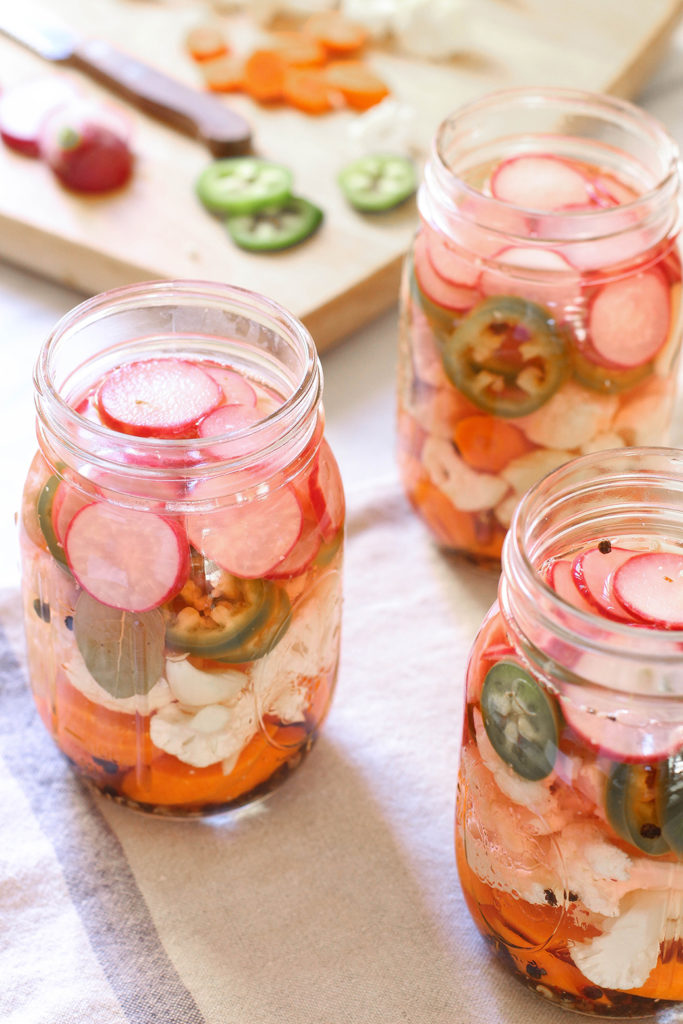
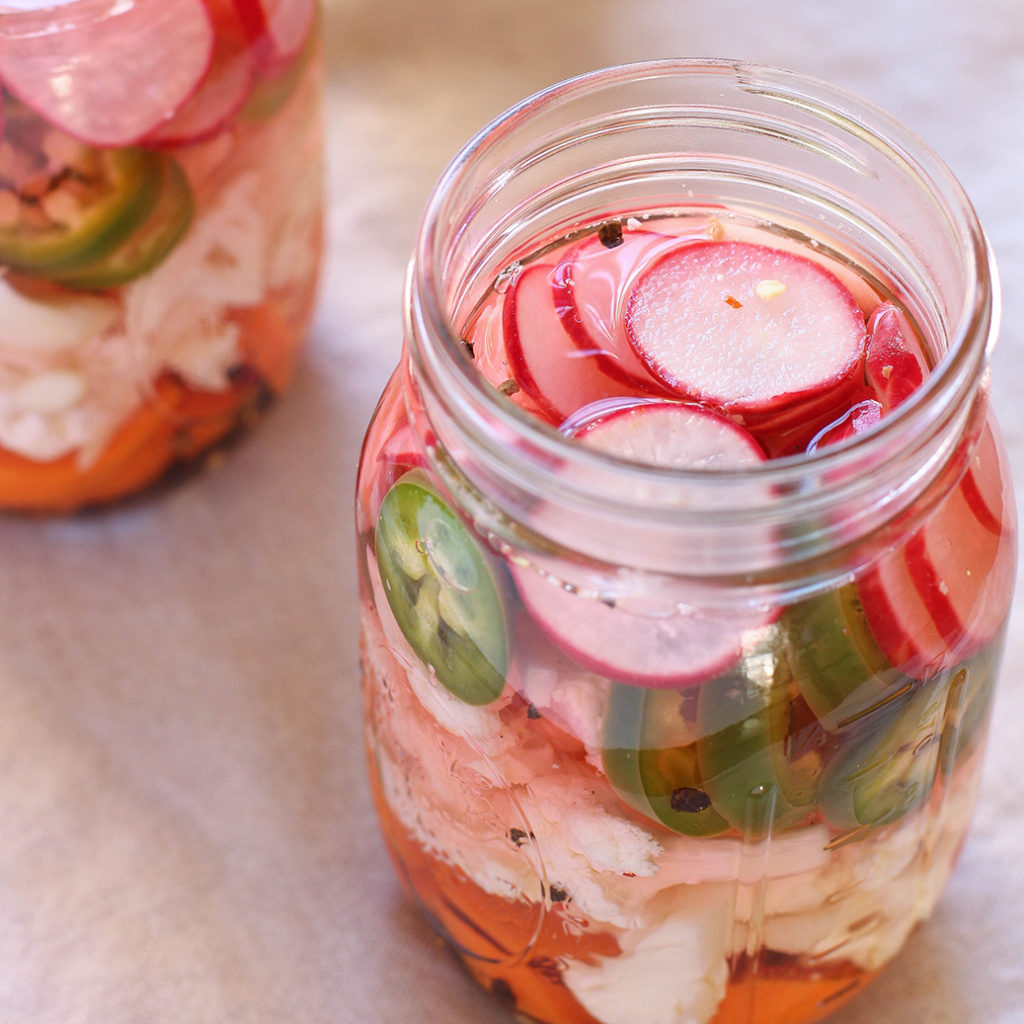
What a fantastic pickle combo – love the radishes and cauliflower! Also love all the benefits that come with fermented foods! Pinning, stumbling and making it!
Thanks so much, Ilka! Weird to think of pickles as being so healthy, but they totally are!
Correct me if I’m wrong, but this is not a fermented food, it is a quick-pickled food.
Yes, that is correct — if you are looking for fermented vegetables, look for salt and water on the ingredient’s list — no vinegar. I wonder if the original escabeche was, in fact, fermented though. Anyone?
If we trace the origins of escabeche back to its earliest forms, it’s possible that it had some connection to fermentation. Before the widespread use of vinegar, ancient preservation methods often relied on natural fermentation processes, especially in the Mediterranean and Middle Eastern regions.
Escabeche likely evolved from ancient practices where food was preserved in a brine or acidic solution, which could have been naturally fermented. In these early forms, the acidity might have come from ingredients like sour fruit juices, wine, or even naturally fermented liquids, which would provide the necessary pH to preserve the food.
So, while the modern version of escabeche is not fermented, its ancient predecessors might have involved some form of natural fermentation, especially when vinegar wasn’t available. This would have been part of the broader tradition of using fermentation and acidic environments to preserve and flavor food.
Escabeche is good, but this recipe is not fermented.
Love this! I have some radishes and carrots in my garden that I am going to try this recipe with…Pinned!
I am jealous of your garden, Angela!
This is delicious! I made it tonight to go with some jackfruit carnitas tacos — perfect condiment (and I didn’t even chill it first; but I bet whatever is left will be even better in the coming days). Thank you!
Awesome, so glad you liked it Ineke!
I love quick pickles and this sounds so very delicious! Thank you for sharing and I am going to try this this weekend!
This looks delicious! The pictures blew me away, they do a great job of making me want to make some escabeche! Thank you for this recipe, can’t wait to try it at home!
Awww, thanks so much, Billy!
I don’t think the vegetables actually go through a fermentation process. Not as healthy but still delicious!
You’re right, Alina. I’m definitely guilty of using the two terms interchangeably.
would this be better if you used a fermentation process?
Hi Michael, not sure what you mean by better. Escabeche is pickled, not fermented like sauerkraut, so it technically wouldn’t be escabeche anymore. The taste would definitely be different if you fermented them (I’m not sure exactly how that process works), but of course there are those who think eating lots of fermented foods is great for your digestive system.
Wouldn’t it become more of a Kimchi
How long do these keep for?
Hi Shannon, I note in the recipe that these can be kept in the refrigerator for up to 3 weeks, possibly longer.
I think that red onions are the best part of Escabeche and an essential part of the flavor of Escabeche. But maybe that’s just me. I eat onions just about every day one way or another.
Can you process this in a water bath to keep a good stock?
We just made this last night. We were surprised how quick the vegetables took on the flavor. This recipe was so easy, cheap, and quick to make. We quadrupled the recipe and love every bite.
Awesome, so glad you’re digging the recipe Mandy!
This is a great recipe. I triple the liquid though – if I have any leftover, I fill smaller jars with whatever I have (onions, carrots, etc.). Everyone loves it when I make this and it goes fast! Sometimes I give it as holiday gifts 🙂 The jars empty jars come back to me quickly lol
Thanks for this really great, easy recipe. It’s perfect!
What a great gift idea! Thanks so much for sharing, Kortneg.
Is it ok to omit the sugar? I’m diabetic.
I am diabetic too. One tablespoon of sugar over 3 15-oz jars and the contents to be eaten over days and weeks should do you no harm. Problem is having to buy the sugar in much larger quantities… Maybe get some sachets when you are next in a coffee shop? I do that often 🙂
I am not sure how the recipe will work without sugar.
Sugar isn’t necessary. It just adds sweetness, and will counteract the spiciness of hot jalapeños. I use a reduced amount.
Is it possible to make a large batch and can it for up to a year or more or does it have to be in the refrigerator?
Hi Kris, I think that they’d have to be refrigerated unless you have some way to vacuum seal the jars.
Because of the vinegar, you can process in a water bath for 10 minutes for pint jars and 15 minutes for quart jars to get a proper seal. The pickles will be slightly softer than the fresh packed ones. You need jars, rings and new lids for pickles and a water bath canner or other deep pot and a rack to lower jars into the water. Fill jars leaving 1/2 inch headspace, clean jar rim, add lid and ring and adjust to finger-tight. Place jars on rack over simmering water. Lower the rack into the water making sure the water covers the jars by 1 inch. Cover canner, bring water to a rolling boil, and process for required time. Turn of heat, remove cover, and let cool for 5 minutes. Remove jars, place on towel or rack (don’t tighten rings if they are loose), and cool for 12 hours. Check seals by checking that the center of the lid is concave and by gently trying to remove lid with finger tips. Wipe off jars and lids, label jars, and store in cool, dry, dark place for up to a year. For more detail on water bath canning check out info freshpreserving.com or a canning instruction and recipe book.
Could I add corn to this recipe as in chunks or raw corn off the cob in place of the radishes?
I don’t see why not!
Corn on the cob is great! (cut 1/2″- 1″ thick) or any vegetable. Greens beans too. I water bath all the time
Can this recipe be canned in a water bath for shelf life? Thanks!
Probably, but the vegetables won’t be as crisp.
I just did a batch of cucumber pickles in a water bath and the biggest difference was that the canned pickles used 2 cups of vinegar to 1 cup of water. You need to watch your acid levels with canning.
I don’t do really spicy 🌶 so I skipped the jalapeños and just used a dash of chili flakes.
And I used daikon radishes! That put some heat back in, and is a good choice if you don’t want color leaching.
Then I used purple carrots and the daikons and cauliflower turned pink!
I ended up tripling the recipe to fill three pickle jars.
I wanted to comment on the not sautéing them choice. The thing about sautéing them, even just for a couple minutes, is how the oil adds to the overall flavor. Makes it richer somehow. I don’t cover when I sauté for maximum crispness, but also makes a different more gentle texture if using cauliflower. Also if you want them to be more authentic I highly recommend using Mexican oregano. I’m with you on using radishes and not onions though. Keeps it all nice and crisp!
My mom made pickled onions ever since I can remember. I absolutely love them! And vinegar is such a great food for diabetics, so it works out fine for me. I think just about any vegetable would work great. Thanks for the recipe!
I searched for the recipe that was simplest. One I’ve made before and yours is a winner. IDK why folks have to complicate what should be easy to make repeatedly. Thank you. I’ve shared jars of these veggies with appreciative friends and sent them you recipe. Again, thank you. Our company fall fiesta was very pleased!
I agree, keep it simple! Thanks so much for commenting David!